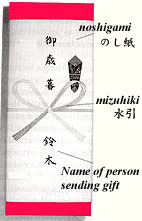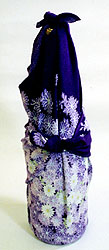
 |
|
When giving gifts or sending presents, it is cumtomary in Japan to accord special care not only to the contents but to the way a gift is wrapped and the wrapping itself. So, when a Japanese gives someone a present, they may feel taken aback if the recipient tears the package apart without thought for the wrapping, even when they know the person does not mean to be rude. In Japan the polite way to open a present, especially in the presence of the giver, is to undo it carefully, without tearing the paper, and some people neatly fold the paper, saving it for reuse.
|
| Tsutsumu |
Wrapping (tsutsumu  ) or tying / binding (musubu ) or tying / binding (musubu ) things has special meaning in the context of Japanese ritual and belief, signifying not only enveloping something with a covering but demarcating it as special and sacred. The significance of tsutsumu can be explained as an act that marks offerings as pure and clean and separates them from dirt or defilement. It is said, moreover, that tsutsumu derives from the word tsutsushimu ) things has special meaning in the context of Japanese ritual and belief, signifying not only enveloping something with a covering but demarcating it as special and sacred. The significance of tsutsumu can be explained as an act that marks offerings as pure and clean and separates them from dirt or defilement. It is said, moreover, that tsutsumu derives from the word tsutsushimu  , which means to be discreet and restrained, and to show respect. , which means to be discreet and restrained, and to show respect.
Tsusumu, or wrapping things, is done not only to keep them clean and protect them from harm, but also to express the giver's heartfelt respect for the person they are presented to; tsutsumu signifies the spirit of giving not only some material thing but feeling from the heart. |
| Gift-giving |
|
Although the many very specific ways once used for wrapping things are not as widely known today as in the past, the spirit of those traditions is still prized. Even young people are particular about the color and type of ribbons and paper used to wrap birthday or anniversary presents and bouquets or flowers sent to others. Often the wrapping is done very simply with minimum of paper and tape, making the gift easy to unwrap. It is sometimes said that Japanese gifts are overwrapped, with various inner layers and very complicated folds, but people do prize and reuse good paper in which they have received gists.
The main occasions of gift-giving in Japan are what are known as "seasonal greetings," the chief of which are chuugen During the chuugen and seibo seasons, department stores and other shops cancel their usual holidays and hold sales of gifts especially designed for this purpose. While seasonal gift-giving is becoming less common among the younger generations, who tend to think of the practice as empty and old-fashioned, it is still vigorously continued throughout Japan.
For all gifts, including chuugen and seibo, there are many detailed rules and customs of wrapping, pertaining to the types and patterns of the paper, the direction of the paper's motif, ways of wrapping, use of traditional mizuhiki |
A seibo  gift gift
|

Noshigami
Mizuhiki |
| Furoshiki |
|
A furoshiki is a square of cloth used for wrapping up things, either for storage or carrying. Furoshiki come in various sizes, from about 70 centimeters square to larger ones 220 centimeters square (approx. 30 to 90 inches square).
The kanji used to write the word A furoshiki can be used, by simply tying the ends toghether, and wrap up things of almost any size and shap, Cunlike a briefcase or bag, which has a predetermined form, it is extremely handy and can be folded up after use to wrap or carry something else. The simplicity and flexibility of the furoshiki wrapping cloth is similar to that of kimono Kimono are made in such a way of length and breadth using sashes and cords. When taken off, however, a kimono folds up neatly into the simple shape of the original strips of cloth from which it was made. Since the end of World War II, most people have opted to use modern-style bags, brief cases and satchels, so furoshiki are not seen as commonly as they once were, except at tradition-centered events such as weddings and funerals. Furoshiki today are made nor only of silk and cotton, synthetic fibers, and are printed with traditional as well as more modern designs. |

|

|
|
Bottle of sake tied up in a silk furoshiki |
Box wrapped in a furoshiki |
| Gifts of Money |
Gifts of cash continue to be common in Japan, but they must be presented in
the proper wrapping, depending on the occasion. The type and decoration of
the wrapping varies for wedding gifts (shuugi  ), condolence gifts
(kooden ), condolence gifts
(kooden  ) at funerals or wakes, or other purposes. Such gifts are a
feature mainly of adult society, but children, too, often receive gifts of cash,
especially in the form of otoshidama or "New Year's presents" from their
parents and relatives. Some children surrounded by generous grown-ups have
the good fortune to receive quite large sums in the form of otoshidama.
These children may buy toys or other coveted items with the money, but many
thriftily put it away in savings accounts. ) at funerals or wakes, or other purposes. Such gifts are a
feature mainly of adult society, but children, too, often receive gifts of cash,
especially in the form of otoshidama or "New Year's presents" from their
parents and relatives. Some children surrounded by generous grown-ups have
the good fortune to receive quite large sums in the form of otoshidama.
These children may buy toys or other coveted items with the money, but many
thriftily put it away in savings accounts.
Otoshidama are also handed over in specially designed envelopes. The characters printed on the envelope in the photograph below are a simplified form of the decoration on the traditional wrapping, which would have been festooned with a noshi strip of folded paper. |
 |
 |
 |
| Shuugi  envelope envelope |
Kooden  envelope envelope |
Otoshidama  envelopes envelopes |
| Way to fold paper for wrapping cash gifts for auspicious occasions (shuugi tsutsumi) |
| This is useful when giving cash that includes coins. |
| 1-2. Align point A with point B. Then fold point A over to align with point C. |
| 3-4. Open the upper flap of the small triangle (X) along the crease and fold by aligning point A with point D, forming a pocket. |
| 5. After placing a coin in the pocket, close the pocket by folding over the corners marked A and D to point E. |
| 6. Adjusting the length of the envelope to the size of currency enclosed, fold up bottom corner of envelope. |
| 7. Close envelope by folding along long side and lapping corner over back. |
| 8. These envelopes can also be used when presenting honorariums or other remunerations. |
 |
Original text : The Japan Forum Newsletter no10 "A day in The Life" June 1998.
Copyright(C)1997-2008 The Japan Forum. All rights reserved.
Send feedback to forum@tjf.or.jp
 "Wrapping " things is more than a convenience in Japan. It is something to which people give special thought and care. Let us consider the meaning of wrapping in Japanese culture, looking at how it is a part of daily life.
"Wrapping " things is more than a convenience in Japan. It is something to which people give special thought and care. Let us consider the meaning of wrapping in Japanese culture, looking at how it is a part of daily life.
 and seibo
and seibo or formal "go-between" presiding over one's marriage. Once it was common to carry such presents directly to the person at their home, but today the normal pattern is to have them delivered by a department store.
or formal "go-between" presiding over one's marriage. Once it was common to carry such presents directly to the person at their home, but today the normal pattern is to have them delivered by a department store.
 string or noshi
string or noshi  many of which have implications for the auspiciousness and message of the gift. When carrying a special gift to give to someone, moreover, sometimes it is first put in an attractively decorated box and then the box wrapped in a furoshiki
many of which have implications for the auspiciousness and message of the gift. When carrying a special gift to give to someone, moreover, sometimes it is first put in an attractively decorated box and then the box wrapped in a furoshiki  until it is presented directly to the person.
until it is presented directly to the person.
 : Paper festoon for a formal gift. Features a noshi, originally a decoratively folded paper with a strip of dried abalone inside, an element symbolizing a happy occasion. A strip of yellow paper may be substituted for the abalone. Today, the noshi and mizuhiki string are often printed on the paper itself.
: Paper festoon for a formal gift. Features a noshi, originally a decoratively folded paper with a strip of dried abalone inside, an element symbolizing a happy occasion. A strip of yellow paper may be substituted for the abalone. Today, the noshi and mizuhiki string are often printed on the paper itself. that were a fixture of every community. People would bandle their towels and washbasin in the furoshiki when setting out for the bath, and then use it to wrap up their clothing while in the bath, as well as a kind of bathmat:
that were a fixture of every community. People would bandle their towels and washbasin in the furoshiki when setting out for the bath, and then use it to wrap up their clothing while in the bath, as well as a kind of bathmat:  furo ("bath") and
furo ("bath") and  shiki ("spread").
shiki ("spread").